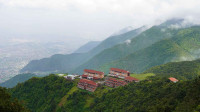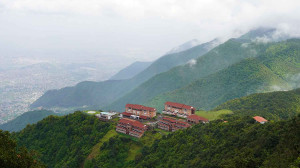Money
Nepal’s economy is on shaky ground. The budget battle begins
Nepal’s unstable politics could hinder the economy, say experts, as the country announces annual budget today.
Sangam Prasain & Krishana Prasain
The floor of Parliament during the budget presentation has been a perennial battleground of Nepali politics.
In recent years, the budget presentation has been chaotic including some instances of physical altercations. To announce the budget, the lawmakers have had to be controlled by marshals.
And this drama may play out this year too.
The ongoing feud between the ruling and opposition parties over forming a parliamentary inquiry committee on the misappropriation of cooperative savings may have spillover effects on the budget, which once again may be introduced through ordinances on Tuesday.
Nepal’s economy, still reeling from the fallout of the pandemic and global geopolitics, is facing an increasingly gloomy and uncertain outlook due to frequent government changes, rampant corruption and irregularities, and the exodus of youths who see no future in the country.
Many of the downside risks flagged by economists have begun to materialise.
Experts say that aside from economic considerations, Nepal’s unstable national politics could also cause problems for the economy.
Some key data released a few weeks ago confirm that Nepal’s construction and manufacturing sector is still in recession. The wholesale and retail sector has avoided the recession while tourism and agriculture have grown slightly.
Economists say the country’s economy is doing badly. As industries are producing less, more people are going jobless. “If lawmakers give low or no priority to bringing the annual budget in the current situation, it will further drag down economic growth,” said Chandramani Adhikari, an economist.
“What is happening currently is not healthy politics. In Parliament, the ongoing politics is more centred on individual interest.”
“If political parties were serious about the country, the principles and priorities of the budget would have been discussed,” Adhikari said. “The budget would have been presented easily, well-discussed, reviewed and approved.”
Even the policies and programmes were delayed and not even discussed, Adhikari said.
Economists say that uncertain budget execution dashes hopes of the entire population.
Opposition parties have demanded a parliamentary probe on the misappropriation of cooperatives savings, particularly pointing the index finger at the incumbent Home Minister Rabi Lamichhane, which the ruling alliance is reluctant to initiate. But this is not the first controversy related to corruption and irregularities that has marred ruling-opposition relations.
Nepal’s economic reforms in the 1990s promised a liberal market-based economy, but even after three and a half decades, successive governments have shown little favour towards private businesses.
“Crony capitalism distorts the efficiency of a free market. Yet Nepal is in the clutches of crony capitalism where limited people, families and communities benefit,” said Adhikari.
Protecting them will only stir up power struggles in politics, bulldozing the hopes and aspirations of the people, he said.
Economist Keshav Acharya said that when the budget comes under political pressure, nobody will take its ownership. Past experiences have shown that the budget undergoes numerous revisions with each new government coming to power.
“The ongoing politics is weighing heavily on the economy. On the eve of the budget presentation, we are uncertain how it is coming. Will it be through ordinances or common consensus?” Acharya said. “Such uncertainty is not helpful when it comes to meeting the budget’s objectives.”
Nepal's private sector contributes over 80 percent to the GDP, making it a crucial driver of economic growth. However, due to the fragile political system, investors have pulled back on investment.
The annual spending of the three tiers of government stands at a combined Rs500 billion. The private sector pumps four times more into the national economy.
Hem Raj Regmi, the deputy chief statistician at the National Statistics Office, recently told a press conference that under the current investment model, the total investment amounts to Rs2.5 trillion. “At this investment rate, Nepal’s economic growth will neither slow down nor grow. It will remain static.”
He said that without encouraging private investment, Nepal will not be able to achieve double-digit economic growth. “We need to increase expenditure. We need to encourage the private sector to invest.”
Rajesh Kumar Agrawal, president of the Confederation of Nepalese Industries, said the private sector wants the bureaucracy and the policies to be stable. “Governments changing every six months will not be a problem if policies remain constant.”
“The fiscal budget is a policy document to drive the economy. The private sector mainly looks for stable policies and their implementation.”
The Nepali economy has historically been stuck in a low-growth trap in the past decades due to a decade-long Maoist insurgency followed by strikes, shutdowns, load-shedding, and earthquakes.
Nepal in 2015 was struck by two powerful earthquakes of magnitudes 7.8 and 7.3 on April 25 and May 12, respectively, killing 8,790 people and injuring 22,300. The economic loss was estimated at $7 billion, out of which 76 percent was in the private sector.
Following the disaster, Nepal’s economic growth rate plunged to 3.98 percent in the fiscal year 2014-15 and decelerated further to 0.43 percent in 2015-16.
But since then, a flurry of post-disaster activities led to a breakneck speed of growth. The Nepali economy grew by 8.98 percent in the fiscal year 2016-17, the highest growth rate since the fiscal year 1993-94.
In 2017-18, the economy grew by 7.62 percent and 6.66 percent in 2018-19, according to the National Statistics Office, formerly the Central Bureau of Statistics, the main government body that deals with the country's vital statistics.
The worst came in 2019-20 when the world was hit by the Covid pandemic. The pandemic-induced supply and demand shock on the global economy caused Nepal's economy to plunge to a negative 2.37 percent.
According to the World Bank, this was Nepal's first annual negative growth rate since 1982-1983, when its economic growth rate plummeted to -2.97 percent.
The statistics office then attributed the negative growth rate to a drought in 1980-81, which in turn led to a severe food crisis.
Nepal’s economy, which rebounded strongly after Covid, has been marred by political instability and haphazard decisions to gain short-term benefits, economists say.
“There is politics everywhere, but that hardly affects most of the country’s economy. In Nepal, if the politics is unstable, the bureaucracy follows suit. That’s a bane for Nepalis and the economy,” said Acharya, the economist.




 6.3200000000001°C Kathmandu
6.3200000000001°C Kathmandu
















